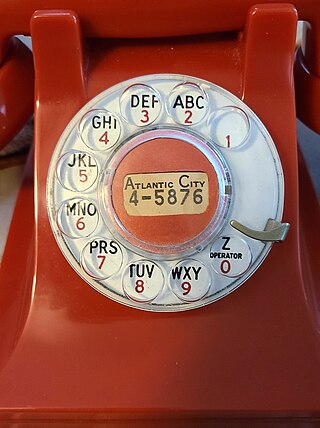
An emergency telephone number is a number that allows a caller to contact local emergency services for assistance. The emergency number differs from country to country; it is typically a three-digit number so that it can be easily remembered and dialed quickly. Some countries have a different emergency number for each of the different emergency services; these often differ only by the last digit.

The North American Numbering Plan (NANP) is a telephone numbering plan for twenty-five regions in twenty countries, primarily in North America and the Caribbean. This group is historically known as World Zone 1 and has the telephone country code 1. Some North American countries, most notably Mexico, do not participate in the NANP.
Automatic number identification (ANI) is a feature of a telecommunications network for automatically determining the origination telephone number on toll calls for billing purposes. Automatic number identification was originally created by the American Telephone and Telegraph Company (AT&T) for long distance service in the Bell System, eliminating the need for telephone operators to manually record calls.
A toll-free telephone number or freephone number is a telephone number that is billed for all arriving calls. For the calling party, a call to a toll-free number from a landline is free of charge. A toll-free number is identified by a dialing prefix similar to an area code. The specific service access varies by country.
In telecommunications, directory assistance or directory inquiries is a phone service used to find out a specific telephone number and/or address of a residence, business, or government entity.

A Zenith number was a telephone service in the United States that allowed a calling party to call the service subscriber at no charge by requesting the name Zenith and the number from a switchboard operator. The service preceded the system of toll-free telephone numbers with area code 800 in the United States. Similar services used the names "Enterprise" or "WX" number.
A telephone numbering plan is a type of numbering scheme used in telecommunication to assign telephone numbers to subscriber telephones or other telephony endpoints. Telephone numbers are the addresses of participants in a telephone network, reachable by a system of destination code routing. Telephone numbering plans are defined in each of the administrative regions of the public switched telephone network (PSTN) and in private telephone networks.

The area code 868 is assigned to Trinidad and Tobago, a member of the North American Numbering Plan (NANP). The telephone numbering plan for the country is known as the National Numbering Plan. It is part of a system used for assigning telephone numbers in Trinidad and Tobago, and functions as a part of the North American Numbering Plan (NANP). It is regulated by the Telecommunications Authority of Trinidad and Tobago, which holds responsibility for telecommunications in the country.

Numbers on the Irish telephone numbering plan are regulated and assigned to operators by ComReg.
Area code 246 is the telephone area code in the North American Numbering Plan (NANP) for Barbados. The sequence 246 spells BIM on an alpha-numeric telephone keypad, a nickname for the island.

The dialling plan for mobile networks and new landline operators is closed; all subscriber numbers must be dialled in full. For landline numbers starting with 02, the dialling plan used to be open; the trunk digit and area code could be omitted if the caller was in the same area code as the callee. However, starting May 3, 2008, all landline numbers must be dialled in full.

The New Zealand telephone numbering plan describes the allocation of telephone numbers in New Zealand and the Pitcairn Islands.

Phonewords are mnemonic phrases represented as alphanumeric equivalents of a telephone number. In many countries, the digits on the telephone keypad also have letters assigned. By replacing the digits of a telephone number with the corresponding letters, it is sometimes possible to form a whole or partial word, an acronym, abbreviation, or some other alphanumeric combination.
The area code 671 is the local telephone area code of the United States territory of Guam. It was created with the beginning of permissive dialing on July 1, 1997, replacing Guam's previous International Telecommunication Union country code 671 at the end of permissive dialing on July 1, 1998.
Telephone numbers in Canada follow the fixed-length format of the North American Numbering Plan (NANP) of a three-digit area code, a three-digit central office code, and a four-digit station or line code. This is represented as NPA NXX XXXX.

A telephone number in Belgium is a sequence of nine or ten digits dialed on a telephone to make a call on the Belgian telephone network. Belgium is under a full number dialing plan, meaning that the full national number must be dialed for all calls, while it retains the trunk code, '0', for all national dialling.
National conventions for writing telephone numbers vary by country. The International Telecommunication Union (ITU) publishes a recommendation entitled Notation for national and international telephone numbers, e-mail addresses and Web addresses. Recommendation E.123 specifies the format of telephone numbers assigned to telephones and similar communication endpoints in national telephone numbering plans.

A telephone number is a sequence of digits assigned to a landline telephone subscriber station connected to a telephone line or to a wireless electronic telephony device, such as a radio telephone or a mobile telephone, or to other devices for data transmission via the public switched telephone network (PSTN) or other public and private networks.
Toll-free telephone numbers in the North American Numbering Plan have the area code prefix 800, 833, 844, 855, 866, 877, and 888. Additionally, area codes 822, 880 through 887, and 889 are reserved for toll-free use in the future. 811 is excluded because it is a special dialing code in the group NXX for various other purposes.
Somos, Inc., is a company that manages registry databases for the telecommunications industry. Additionally, since January 1, 2019, the company has been the North American Numbering Plan Administrator, under a contract granted by the Federal Communications Commission.










